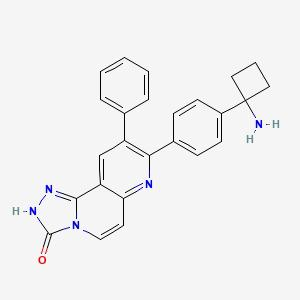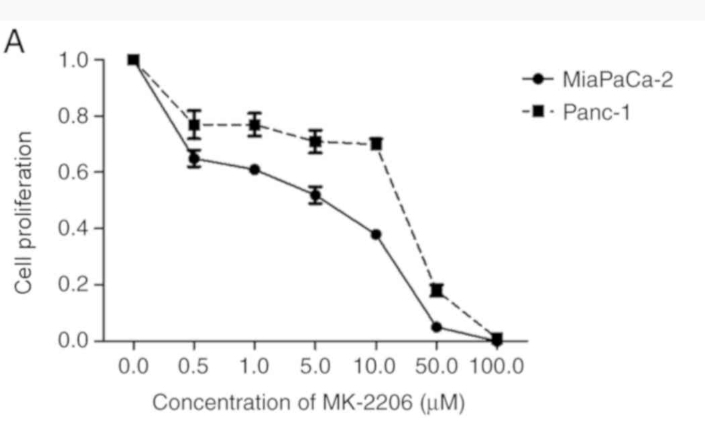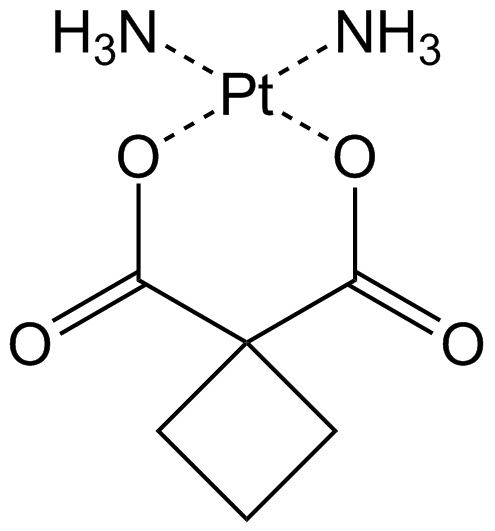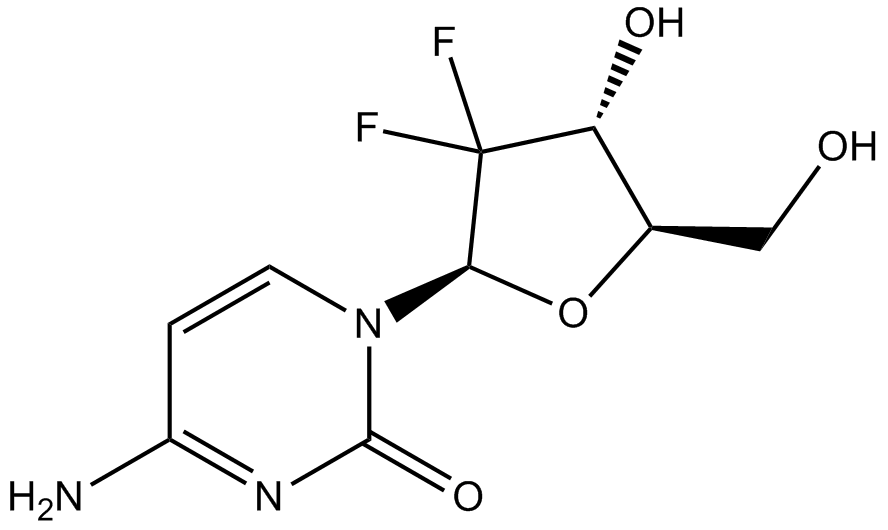MK-2206 dihydrochloride
It is defined as a novel synthetic compound that can be administered orally for the allosteric inhibition of Akt. This novel molecule requires the pleckstrin homology domain for its action and that’s why it acts as a selective inhibitor of Akt. Studies reported that it is equally potent to inhibit the AKt1 and Akt2 enzymes but is almost 5 times less potent to inhibit the Akt3 enzyme. As we know that Akt is the serine-threonine kinase enzyme that is activated via several growth factors through the PI3K signaling pathway. Kinases are essential for the cell’s survival ability and growth of the cells. Studies indicate that the tumor cells have abnormal activation of the PI3K signaling pathway, due to which cancer cells start to grow and proliferate in an uncontrolled manner. PI3K signaling pathway also regulates the level of apoptosis of the cell in the body by inhibition. For this pathway, Akt3 acts as a mediator to control the apoptosis response of the cells. So AKt as an antiapoptotic factor leads to the survivability of not only healthy cells, but also for cancer cells. It is because, the cancer cells have greater expressions for PI3K signaling pathway. Akt behaves as an antiapoptotic factor for different stimuli for cell death including; osmotic stress, oxidative stress, ischemic shock, and the treatment with the help of chemotherapeutic agents. This overexpression leads to the cancer cells’ resistance to chemotherapy and radiotherapy. So, it will be a great opportunity for the use of molecules that can inhibit the Akt, not only in the treatment of various types of cancer, but also resolves the chemotherapy resistance against cancer cells. Hence the MK-2206 can be used to treat solid tumors by inhibiting the AKT. Studies indicated that this can be used along with neoplastic agents in different cancer models of NCI-H460 or ovarian A2780 cell lines. This data stated that, MK-2206 synergistically acts along with different chemotherapeutic agents including doxorubicin, gemcitabine, etc. to inhibit the cancer cells growth in a dose-dependent manner. This study clearly stated, that the combined treatment of MK-2206 and carboplatin or the pretreatment with carboplatin before the administration of MK-2206 increases the chances of A2780 cancer cell lines. But the administration of MK-2206 before carboplatin does not increase cell death effectively. The results of this study indicated that, MK-2206 increases the chance of cell death with the help of carboplatin through the activation of the caspase cascade. Similarly, combined therapy of gemcitabine along with the MK-2206 in human NSCLC cell lines NCI-H460 inhibits the growth along with the greater antitumor efficacy. This study explained that the alone therapy of gemcitabine (p=0.0268) and of MK-2206 (P = 0.0066) produce a moderate antitumor action. Meanwhile, their combination therapy produces a significant response as compared to monotherapy.

Figure 1: Structure of MK-2206
One of the studies conducted on the effects of MK-2206 on the pancreatic cell lines explained that it can be used as a therapeutic option for the treatment of pancreatic cancer. As we know that the pancreatic cancer cell lines have overexpression of the PIK3/Akt signaling pathway. In this study, they use different cell lines of pancreatic cancer including Panc-1, Capan-2, Mia PaCa-2, AsPC-1, etc. They explained that the PANC-1 and Mia PaCa-2 show a greater level of overexpression of the PIK3/Akt signaling pathway as compared to the Capan-2 and AsPC-1. Similarly this PANC-1 and Mia PaCa-2 show greater resistance to chemotherapeutic agents like gemcitabine as compared to other cell lines. So, they select PANC-1 and Mia PaCa-2 cell lines for their experiment and measure the effects of MK-2206 on these cell lines alone or in combination with gemcitabine. They used flow cytometry analysis to determine the level of apoptosis in these cells and western blotting techniques to study the drug effects on cancer cell lines. They found that the MK-2206 increased the rate of apoptosis in PANC-1 and Mia PaCa-2 cell lines along with the decrease in the phosphorylation of Akt. The same effect can be observed for the gastric cell lines, thyroid cell lines, and neuroblastoma cells. In the past alone use of gemcitabine is considered the best chemotherapy approach for the treatment of such cancers, but major of the patients do not respond well and gives resistance to cancer cell lines. Previously published research revealed that gemcitabine increases the expression of the Akt pathway by increasing the production of reactive oxygen species in pancreatic cancer cells. This behavior leads to a decrease in the drug efficacy as the antitumor potential for pancreatic cancer cells. On the other hand, combined therapy of gemcitabine along with the MK-2206 improves the results of gemcitabine by decreasing the overexpression of the AKT signaling pathway through the inhibitory effect. This leads to an increase in the cytotoxic effects of gemcitabine against pancreatic cancer cells in in-vivo conditions. Hence decrease the chemotherapy resistance for gemcitabine.

Figure 2: inhibition of pancreatic tumor proliferation via using MK-2206 in pancreatic cancer cells line: PANC-1 & Mia PaCa-2
Similarly, a phase 2 study conducted on the effects of MK-2206 on the breast cancer cells that have PTEN loss, PTEN mutations, or PI3KCA/AKT1 stated that it can be used to improve the patient’s condition suffering from advanced breast cancer. This study exhibited that the monotherapy that only includes the MK-2206 does not sufficient enough in advanced breast cancer conditions instead it has some expected profile toxicity including 3-grade rashes. They stated that the breast cancer cells that have PI3KCA/AKT1 mutation and PTEN mutations are more sensitive to the action of MK-2206. But overall, in advanced-stage patients, the clinical activity is somewhat low. They considered that it may be due to their patients being heavily pretreated and having activated several pathways that account for the less efficacy. Although the previous studies conducted on breast cancer indicated that the MK-2206 decreases the expression of the Akt signaling pathway in in-vitro conditions and decreases the growth and proliferation of the tumor cells in in-vivo conditions in a dose-dependent manner. Recently several clinical trials have been reported in which they got limited to modest activity against Renal cell carcinoma and lymphoma respectively.















Comments